These last few weeks I have barely had a camera in my hands. Instead I have been doing a ton of post processing work (my least favourite activity), taking courses, workshops and other pursuits. I miss taking pictures. Oh well, I am anticipating many more shooting opportunities in December.
I may not have been shooting but I have been reading many blogs and web sites about the new Canon gear. The 7D and the 1D Mark IV. I was lucky enough to attend the Canon 7D launch event about a month back and man, I tell you, it was everything I could do to keep my wallet in my pocket. But experience has taught me not to jump at every new product that comes down the pipeline. When the 50D was introduced I could not wait to hand Canon my money but in the end I chose the 40D as my replacement for my well used Rebel XTi. A year later I could not be happier with my decision. Lately though I have been getting eager to relegate the 40D to backup and bring home a new Canon. I thought for sure the 7D was going to be the one but now I'm not so positive.
Small Pixels Equals More Noise
My 40D has a resolution of 10 megapixels on an APS-C size sensor, which translates in to each light gathering pixel being 5.7 microns in size - same size as my Rebel Xti. One would expect the picture quality to be roughly the same, and, yes it is. When the 50D first came out I tried one out for about a week before settling on the 40D. Why? A couple of reasons. The images were really noisy above ISO 1600 and using DPP (Canon's Digital Photo Professional software) to remove the noise made the images too soft. If I switched on in-camera noise reduction the images also came out too soft. Secondly, I found the 50D images lacking the sharpness of my Rebel XTi. I played around with in-camera settings and post processing techniques but I could not find the sweet spot. Was the 50D, with its increased pixel density, harder to hand hold? Or did the increased pixel density of the sensor inherently produce softer, noisier images? I don't know. But I do know I was not satisfied with the quality so I passed and chose the 40D instead.
One year later and the 7D arrives on the scene. Oh boy was I excited!! As soon as the specifications were out I read all about it. Eight frames per second - awesome! 100% viewfinder - incredible at that price point! All new autofocus system - yah! And then.... 18 megapixels on an APS-C size sensor. Woah! What?!?!? Are you kidding me?!?! Yup. It's true. The Canon engineers found a way to squish even more pixels on that tiny sensor pushing the pixel size to a miniscule 4.3 microns - the smallest of any camera in the EOS line. I was stunned and saddened.
I had to read more about it. Turns out Canon performed some amazing engineering tricks to make 18 megapixels on an APS-C sensor produce high-quality images. But let us skip all the fancy explanations of how and why because I failed grade 11 physics. OK, full disclosure, I didn't try too hard in high school. Clowning around proved to be more fun. Seriously though the general consensus is that smaller pixels have less light gathering ability and thus produce softer images with more noise. I know Canon has truly outdone themselves with the engineering on this sensor but I am still skeptical, especially after my experience with the 50D.
I have read some pretty positive reviews of the camera from The Digital Picture and Rob Gilbraith but there are questions of image quality. However, DPReview.com gave it a "highly recommended" review and had no qualms about the image quality. Personally, for the short time I got to play with it I must admit that the thing feels and handles like a dream and has an incredible feature set, especially at that price. I did a quick cursory check of the image quality and I did find it very similar to the 50D. Similar not in a good way.
As much as I would like to run out and buy one, the most prudent course of action for me will be to rent one for a day, put it through the paces and see if it meets my needs and my tastes. There really is no better way to do it.
One Last Thought...
I cannot help to wonder what if Canon stopped the megapixel madness and capped the 7D at 15 megapixels (same as the 50D) and applied the same engineering techniques to the sensor. Would we be seeing stunning low-light images? Less noise? More sharpness and more dynamic range? Sigh. I can only imagine.
Although I was not impressed with the 50D images on the screen I was quite impressed with the prints. The level of detail was simply amazing. I expect the 7D, with 80% more pixels than my 40D, to produce some pretty amazing output as well. But will it take a bunch of post processing effort to produce stunning prints or screen output?
I am one person who would rather be taking pictures than making them on my computer.
Sunday, November 29, 2009
Sunday, November 22, 2009
What's Wrong With This Picture?
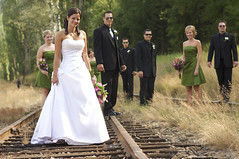
I consider this to be a good shot. It was my only my second wedding gig and a job I got completely by surprise. I was not supposed to be the photographer for this wedding, I was a guest. But the task became mine after the original photographer failed to show. The plus about getting the job at the last minute? No time to get nervous. The minus? No time to prepare. You can read about the back story in this post.
This past Saturday I was in my last "Digital Darkroom" class making some prints of the images that I took of a wedding over the summer. On the workstation beside me was Patrick Kornak, one of my instructors from other photography classes. He's a great guy and always very generous of his time to help others. My images caught Patrick's eye and he leaned over and offered a quick critique. Patrick has been shooting pictures since he was 12 years old so if he is willing to offer a little critque, I'll take it.
A little about critque...
An honest critique of your images is absolutely invaluable. Some people fear having their work evaluated by their peers or superiors. I relish it! Sure we can all take it too personally and it can be a little deflating sometimes but if you are fortunate enough to have a skilled and unbiased individual evaluate your images it truly is a fantastic opportunity to learn and grow. My only two pieces of advice when looking for someone to critique your work is a) find someone who knows the craft and b) look beyond friends and family. Unless your mom is Annie Leibovitz, she will probably not give you the unbiased feedback you need.
So what is wrong with this picture?
Really there is nothing "wrong" with it but there are a few things that could be improved.
Technical? The technical is good. Exposure, colour balance, sharp subject - all the basics are there.
Composition? Well, here is where Patrick made some good suggestions. I added some letters to the image below so the trouble spots could be quickly identified.
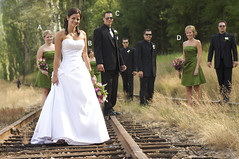
Let us start with "A". This girl is too close to the subject. She ends up being a bit distracting and we do not see all of her like we do the others. We should probably switch her up with girl "D" or at the very least put some distance between her and the bride.
"B" has pretty much the same problem as "A". She crowds the subject and gets lost behind all the others. She might be better over where "A" was but with a bit of a gap between her and the bride. Despite me constantly reminding people that "if you can't see the camera, the camera can't see you" some people still found a way to get lost. Truthfully though this bunch was great to work with and any one of them getting lost in the shuffle is my fault, not their's.
Mister "C" (the groom) needs one small tweak. Remove the shades! It is minor but I really want to see the eyes of the bride and groom. I'm not so concerned about the rest of the wedding party as they are deeper in the background but the B & G need to be looking good and consistent at all times. If both wanted to wear sunglasses, fine, it is their choice. But to have one with and one without is certainly not the best.
And finally, "D". Her position in the frame is good but Patrick thought she could use a small adjustment to get her looking even better. His suggestion was to have her bend a bit in to one knee and put the weight on her back foot. This will help to accentuate the feminine form. Guys are a bit easier. As long as they aren't making a rude gesture or picking their nose when you snap the picture, you're golden. Ha ha!
So what was good about the shot? Patrick thought the arrangement, although somewhat unconventional, really worked well and he also commended me on the nice leading lines of the train tracks bringing the eyes right to the bride and groom. But more than anything else, the bride and groom loved the shot and their opinion is the most important of all.
Keep shooting pictures and keep on learning.
Sunday, November 15, 2009
The Quest for Creativity...
Creativity. Can it cultivated? Sure. Why not? Do you want to read a really, really long article all about creativity? You can read it on Wikipedia here. If not, you can just read on and I will tell you a bit about how I'm trying to encourage a bit more inventiveness in my own photography.
Several months ago I began a "creative" self-project. The idea was simple. Pack the camera more often and take pictures of anything and everything to spark more imagination. And at the same time and probably more important - think less. A few posts back I revealed that I have a tendency to "over think" pictures. Too much technical, not enough natural.
 My creative project has produced a number of "keeper" shots (see photo at right). But more than just making pretty pictures the project has encouraged me to vary my thinking and to try new things - experiment a bit more.
My creative project has produced a number of "keeper" shots (see photo at right). But more than just making pretty pictures the project has encouraged me to vary my thinking and to try new things - experiment a bit more.
To stimulate the creative juices even more I picked up a copy of A Whack on the Side of the Head. I guess it's one of the creativity classics written over 25 years ago. I like what I have read so far (I'm not quite done yet. I am a super-slow reader and easily...hey, check that out... distracted). I imagine the book is something that can be read again and again when you need help to kick start some fresh ideas.
The project is ongoing and continues to produce some interesting shots. Below is one from the very beginning of the project back in the Summer.

The frame was something put up by the City to highlight the various landscapes and scenes around the park. I picked a nice composition through the frame, backed up enough to show the entire frame and the surrounding scene, tossed in a little fill flash and voila!
And here is another taken just a few weeks ago.
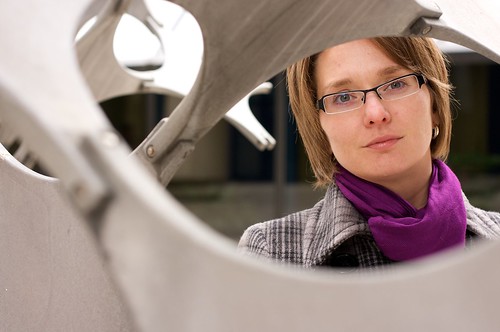
The creative project is encouraging new ideas, experimentation and more playfulness. I intend to keep it running for a long, long time.
I guess the only question you need to ask yourself to foster more artistry and imagination in your own images is "I wonder what it would look like if I tried this???".
Have fun!
Several months ago I began a "creative" self-project. The idea was simple. Pack the camera more often and take pictures of anything and everything to spark more imagination. And at the same time and probably more important - think less. A few posts back I revealed that I have a tendency to "over think" pictures. Too much technical, not enough natural.
 My creative project has produced a number of "keeper" shots (see photo at right). But more than just making pretty pictures the project has encouraged me to vary my thinking and to try new things - experiment a bit more.
My creative project has produced a number of "keeper" shots (see photo at right). But more than just making pretty pictures the project has encouraged me to vary my thinking and to try new things - experiment a bit more.To stimulate the creative juices even more I picked up a copy of A Whack on the Side of the Head. I guess it's one of the creativity classics written over 25 years ago. I like what I have read so far (I'm not quite done yet. I am a super-slow reader and easily...hey, check that out... distracted). I imagine the book is something that can be read again and again when you need help to kick start some fresh ideas.
The project is ongoing and continues to produce some interesting shots. Below is one from the very beginning of the project back in the Summer.

The frame was something put up by the City to highlight the various landscapes and scenes around the park. I picked a nice composition through the frame, backed up enough to show the entire frame and the surrounding scene, tossed in a little fill flash and voila!
And here is another taken just a few weeks ago.

The creative project is encouraging new ideas, experimentation and more playfulness. I intend to keep it running for a long, long time.
I guess the only question you need to ask yourself to foster more artistry and imagination in your own images is "I wonder what it would look like if I tried this???".
Have fun!
From White to Black...
About a month back I did some shots for a local yoga studio. They were straight up shots - pure white background using natural light for the subjects and just a bit of flash on the background to make sure it was indeed pure white. I was very pleased with the results! You can read about it and see some of the pictures from the shoot here.
A few weeks ago I did another session with Sasha Bahador who is an amazing yoga instructor and beautiful person. You read more about Sasha on her website. For this shoot we wanted a bit more mystery and not such a sterile, clean look. This time I choose to shoot on a black background and light just the subject with flash.
Black is the opposite of white. Duh. I know that sounds dumb but with a white background we need light to make sure it's not a yucky greyish colour, and, we need a lot of light if we want to make it pure white. For black we have to do the opposite. If we want it pure black we have to be carefully not to allow light to spill over it. Seems easy enough but it can present some challenges. My lighting setup was fairly simple, a Canon 580EX II flash on either side of the subject shooting through an umbrella, triggered with MicroSync remotes. To keep light from spilling on to the background I kept one half of the umbrella cover on, which worked well. And, when called for, the lovely Jen hand held another 580EX II to act as a hair or separation light.
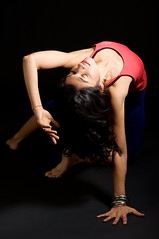
Most of the pictures where done with a 580 EX II on either side of the subject but on occasion one flash would fail to fire and we would get a completely different look. At first I considered it a "problem" and quickly fixed the issue but after reviewing some of the pictures, it turned out that we liked the look. It gave the pictures more of a dramatic appearance. For a whole series I turned off one of the strobes so that only Sasha's face, torso, arms, etc were lit and let the lower half of the image fall in to shadow.
Sasha brought a beautiful sari with her that we tried desperately to work in to the pictures. As a background I did not think it worked very well. Either it was lit too much or too little - overwhelming or underwhelming the image. Eventually, after much play we finally found a few ideas that worked. For one shot we used the sari as a background, splashed a bit of light on it and made it slightly off centre from the subject. It added a nice bit of interest in the background. I queued Sasha through a few experimental poses and I was able to capture some playful, candid looks.

We continued to play and one of the final shots turned out to be my favourite.
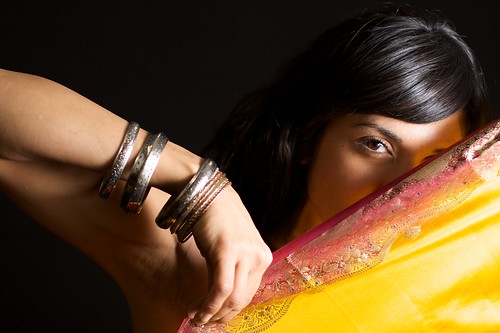
Every time I pick up the camera I learn something new and this shoot was no different. I received a gentle reminder that sometimes the best pictures come from a bit of luck, play or experimentation. It's easy to get too focused on one outcome or idea and miss so many other beautiful opportunities - stay flexible. Another important lesson was to take the odd break from shooting, pull some pictures up on the computer and see what is working and what is not. I did that a few times and instantly we came up with some great ideas and found certain poses that we wanted to work a bit more.
Keeping taking pictures and keep learning.
A few weeks ago I did another session with Sasha Bahador who is an amazing yoga instructor and beautiful person. You read more about Sasha on her website. For this shoot we wanted a bit more mystery and not such a sterile, clean look. This time I choose to shoot on a black background and light just the subject with flash.
Black is the opposite of white. Duh. I know that sounds dumb but with a white background we need light to make sure it's not a yucky greyish colour, and, we need a lot of light if we want to make it pure white. For black we have to do the opposite. If we want it pure black we have to be carefully not to allow light to spill over it. Seems easy enough but it can present some challenges. My lighting setup was fairly simple, a Canon 580EX II flash on either side of the subject shooting through an umbrella, triggered with MicroSync remotes. To keep light from spilling on to the background I kept one half of the umbrella cover on, which worked well. And, when called for, the lovely Jen hand held another 580EX II to act as a hair or separation light.

Most of the pictures where done with a 580 EX II on either side of the subject but on occasion one flash would fail to fire and we would get a completely different look. At first I considered it a "problem" and quickly fixed the issue but after reviewing some of the pictures, it turned out that we liked the look. It gave the pictures more of a dramatic appearance. For a whole series I turned off one of the strobes so that only Sasha's face, torso, arms, etc were lit and let the lower half of the image fall in to shadow.
Sasha brought a beautiful sari with her that we tried desperately to work in to the pictures. As a background I did not think it worked very well. Either it was lit too much or too little - overwhelming or underwhelming the image. Eventually, after much play we finally found a few ideas that worked. For one shot we used the sari as a background, splashed a bit of light on it and made it slightly off centre from the subject. It added a nice bit of interest in the background. I queued Sasha through a few experimental poses and I was able to capture some playful, candid looks.

We continued to play and one of the final shots turned out to be my favourite.

Every time I pick up the camera I learn something new and this shoot was no different. I received a gentle reminder that sometimes the best pictures come from a bit of luck, play or experimentation. It's easy to get too focused on one outcome or idea and miss so many other beautiful opportunities - stay flexible. Another important lesson was to take the odd break from shooting, pull some pictures up on the computer and see what is working and what is not. I did that a few times and instantly we came up with some great ideas and found certain poses that we wanted to work a bit more.
Keeping taking pictures and keep learning.
Sunday, November 8, 2009
Which Lens? When?
I attended a two hour "Creative Lens Choice" workshop put on by Darwin Wiggett and The Camera Store today. It was two hours well spent. Darwin is an amazing photographer. His presentations are always rich with information and he is an entertaining and enthusiastic speaker - worth catching if you have the chance.
I wanted to share a one quick bit of information from the workshop that really stuck with me. Just like the name of the today's presentation suggests, it is about making creative lens choices.
You cannot make a creative lens choice unless you actually know a bit about the lens types and the effects they produce. Lenses can be broken down in to three basic categories based on focal length - wide angle, normal and telephoto. Wide angle is typically anything less than the "normal" perspective. Normal perspective is what we see, which is approximately the angle of view produced by a 50mm lens on a full-frame camera. So 14mm, 24mm and a 17-40mm zoom would all fall in to the wide angle category. Telephoto takes us beyond the normal perspective and produces a much narrower angle of view. Lenses like 100mm, 70-200mm zoom and 300mm are examples of telephoto lenses.
Each of these types of lenses have different properties and produces a unique effect. Darwin broke it down by lens type and the effect. It looked something like this:
Wide angle = Big foreground, small background and expanded distance
Normal = Well, normal. How we see things with our own eyes.
Telephoto = Small foreground, big background and compressed distance
Simple.
So next time you are out there shooting pictures think about these lense types, the effects they produce and how you can use that to your creative advantage.
Awesome.
I wanted to share a one quick bit of information from the workshop that really stuck with me. Just like the name of the today's presentation suggests, it is about making creative lens choices.
You cannot make a creative lens choice unless you actually know a bit about the lens types and the effects they produce. Lenses can be broken down in to three basic categories based on focal length - wide angle, normal and telephoto. Wide angle is typically anything less than the "normal" perspective. Normal perspective is what we see, which is approximately the angle of view produced by a 50mm lens on a full-frame camera. So 14mm, 24mm and a 17-40mm zoom would all fall in to the wide angle category. Telephoto takes us beyond the normal perspective and produces a much narrower angle of view. Lenses like 100mm, 70-200mm zoom and 300mm are examples of telephoto lenses.
Each of these types of lenses have different properties and produces a unique effect. Darwin broke it down by lens type and the effect. It looked something like this:
Wide angle = Big foreground, small background and expanded distance
Normal = Well, normal. How we see things with our own eyes.
Telephoto = Small foreground, big background and compressed distance
Simple.
So next time you are out there shooting pictures think about these lense types, the effects they produce and how you can use that to your creative advantage.
Awesome.
Subscribe to:
Posts (Atom)

